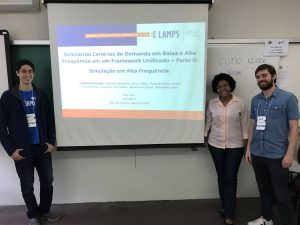LAMPS e Grupo Energisa no SPBO 2018
This month, on August 6-9, PUC-Rio held the fiftieth edition of SBPO, the Brazilian Symposium on Operational Research. Our team contributed with 8 papers on issues ranging from financial strategies to energy planning.
Among the works presented, we highlight three papers developed within the scope of the R&D project being conducted, since May 2017, in partnership with Energisa Group, which has been betting hard on a paradigm change concerning the transmission system usage amount.
The main challenge regarding this endeavor consists in simulating long-term energy demand scenarios, considering the uncertainties inherent to the process, to then determine the optimal contract amount through a stochastic programming model. In short, developing the theoretical-methodological framework that will help Energisa to define and apply an effective contracting policy that recognizes that the contracting strategy is a risk-averse decision problem affected by the uncertainty in the future load, internal renewable generation, and network contingencies.
Paper #1: “Simulating Low and High-Frequency Energy Demand Scenarios in a Unified Framework – Part I: Low-Frequency Simulation”
Raphael Saavedra, Guilherme Bodin, Érica Telles, Thuener Silva, André Milhorance, Cristiano Fernandes, Alexandre Street, Armando Leite
Abstract
Energy demand prediction is a strategic tool for distribution companies due to the need to contract the amount of use of the transmission and distribution systems. However, most of the literature focuses on forecasting rather than simulation. The generation of future scenarios is essential to capture the inherent uncertainty of the process and to allow for a risk-averse decision making framework. The first of this two-paper series proposes a methodology to simulate long-term, low-frequency energy consumption scenarios through state-space models. An open-source Julia package containing the implementation of the time series state-space modeling, Kalman filter and maximum likelihood estimation is made available. Finally, a case study with real data from the Brazilian power system is presented.
Access to the full article coming soon.
Paper #2: “Simulating Low and High-Frequency Energy Demand Scenarios in a Unified Framework – Part II: High-Frequency Simulation”
Guilherme Bodin, Raphael Saavedra, Érica Telles, Thuener Silva, André Milhorance, Cristiano Fernandes, Alexandre Street, Armando Leite
Abstract
The second half of this two-part paper proposes a novel methodology to simulate long-term, high-frequency scenarios for the power demand in each bus of a distribution system. The proposed model generates high-frequency and high-dimensional scenarios, on an hourly basis, for each bus of the system, as a function of the low-frequency and low-dimensional scenarios simulated by the first part of this work. Hence, the proposed method relies on a disaggregation procedure that is trained within observed data and applied to long-run simulated scenarios. A case study with real data from the Brazilian power system is presented,and relevant conclusions are drawn. We highlight that this method can be useful for a wide range of applications in power systems.
Access to the full article coming soon.
Paper #3: “Risk-Averse Contracting Strategy for the Transmission System Usage”
Érica Telles, Raphael Saavedra, Guilherme Bodin, Thuener Silva, André Milhorance, Cristiano Fernandes, Alexandre Street, Armando Leite
Abstract
Brazilian distribution companies (DISCOs) need to contract the amount of transmission usage, i.e., maximum demand within a given horizon, at each connecting bus within the transmission system. This contracting scheme signalizes the future demand needs for the system planner through a decentralized market-based demand forecast. From the DISCO’s part, the definition of the optimal contract amount involves a set of uncertainties such as the entrance of new clients, network contingencies, and climatic variables affecting both the demand and renewable generation within the DISCO’s network. This paper proposes a stochastic linear programming model to optimize the contract amount of the transmission usage for a given set of scenarios and probabilities that depicts the uncertainties of the problem. The Conditional Value at Risk (coherent risk measure) is used to represent the DISCO’s risk aversion through parameterized risk constraints and a risk-adjusted objective function.
Access to the full article coming soon.




